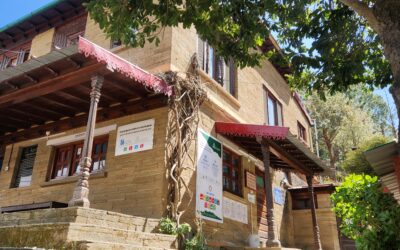While exploring the collections in the PRAYOG library, I stumbled upon some books featuring striking, zoomed-in illustrations in warm colours. Among these, one title stood out: Pongal. Frequently mentioned by colleagues as a significant work on caste, I was intrigued by their frequent references to it as an exceptional book. This discovery led me to delve into the world of Bama, the author behind these compelling stories.
I read two of her books, ‘Pongal’ and ‘Mirchi Ka Chura’. Set up in a village in Tamil Nadu, both are illustrated by Karen Haydock and published by Muskaan. Our collection includes Hindi translations of these short stories, originally written in Tamil, and translated by Amita Suri and Rama Vedula respectively. The raw and captivating illustration on the cover caught my eye.


Pongal
‘Pongal’ was the first book I read. Displayed on a beautiful, small, white wooden rack hanging on the wall partitioning the two-room library, in the ‘Caste’ section, it captured my imagination since my first day at the PRAYOG library. The blue background and large yellow title, ‘Pongal’ with its intriguing cover illustration, immediately drew me in.
The title piqued my curiosity — was the author writing about the Pongal festival or the dish? What was the connection between Pongal and the caste? Being a Tamil who was raised in Uttar Pradesh, I was not aware of how caste dynamics played out during various festivals. Moreover, I was thrilled to find a book about Pongal, a festival that always reminded me of my roots. Pongal corresponds to the Makar Sankranti celebrated in the northern states. While living in Uttar Pradesh, we used to celebrate this festival by offering prayers to the sun god and enjoy various delicacies. The four day long festival used to end by wishing family and friends.
After a series of curious glances for months, one day, I finally committed to reading it. As soon as I opened it, I read each passage twice and immersed myself in the illustrations. The first reading left me feeling content and thoughtful about the choice of words, the actions of characters and the climax.
The story, written in a narrative style, allows readers to understand the perspectives and situations of each character. It follows Madsami and his family, who have a tradition of giving gifts to their zamindar (landlord) every Pongal. Often, these gifts are exclusive and what they themselves have never consumed. The story also highlights the son’s argument against this obligatory and unaffordable tradition. When the son, Esskimuthu, throws the cheap towel from his neck which was given as a gift from the Zamindar last Pongal, it reflects to me as standing up against continuous evil practice. This narrative effectively captures the consistent tension between the son and his parents and their eventual realisation of their son’s perspective.
Each page features colourful illustrations rich with meaning. One such very expressive illustration shows a pyramid like structure implying social hierarchies and prompting the readers to pause and reflect on harsh caste realities. The figure portrays how the entire weight of the caste-centric society is carried by the most downtrodden and the most populous section. At the top of this pyramid are two pairs of large feet implying the extra-ordinary oppression of lower caste by the elite upper caste.
Mirchi Ka Chura
‘Mirchi Ka Chura’ (chilli powder) or ‘Molgapodi’ in Tamil, was the second book I read in my discovery of Bama. The writing is as raw as it gets, with realistic characters such as the protagonist Pachamma and the antagonist Gangamma, and the broader community. The story revolves around the life of a Dalit landless woman labourer named Pachamma in the village, depicting her character gradually developing into an emancipator. A regular woman who is expected to keep her head down and perform her duties, she stands against injustice, the hierarchical status quo in her village. Bama’s Pachamma is brave, boastful and clear in her acts.
The title of the story comes from this incident between Gangamma and Pachamma where the former throws ‘mirchi ka chura’ in the eyes of the latter as a punishment for taking grass from her field. Gangamma who has a higher stature in the village due to her caste, land and wealth is feared by everyone except Pachamma. In an incident that follows, Gangamma catches Panchamma and her fellows stealing cotton from her field to sell for food. This confrontation leads Pachamma and her fellows to the police station, where the police openly sided with Gangamma. At the station, she speaks up against the one-sided justice and the mistreatment of the Dalit women by the police. Mounting an offensive on the looming patriarchy and casteism, she defends herself and others in front of the authority. After coming back from the police station, when her husband questioned her character, she took a bold stance against his accusations.
As I read the story, I was surprised by the use of language, which is nowhere near what is supposed to be socially sophisticated by the patriarchal society. Bringing out the gravity of the subject, the bluntness of language put me in the shoes of characters. These instances in the story compelled me to question our set societal norms and notions. The story questions the existing definitions of public and private property and compels me to question the set beliefs of. It made me reconsider the pre-existing societal ideas about private and public property, theft and morality amid the harsh poverty and discrimination.
Discovering Bama
Both these books, through the actions of their main characters, bore a rebellious nature. In ‘Pongal’, Madsami’s son Esskimuttu throws away the towel given by the Zamindaar to disassociate himself from the shackles of oppressive customs. Similarly, in ‘Mirchi Ka Chura’, Pachamma stands against the feared Gangamma with all her might, voicing out her community’s rights. Both acts symbolise rebellion against the deeply unequal status quo present in protagonists’ societies.
In ‘Pongal’, I was seeing the influence of education as Esskimuthu is the only one with formal education. Now I can’t be certain about it, that it was only due to education that he could stand against the one sided custom because in the second book, there is no mention of Pachamma’s education background, but we see her standing against injustice, for herself and even her community. However, what comes out of this are two things – 1) the role of education and 2) the self-awareness and courage that one posses to stand against something or someone.
Bama Faustina Soosairaj is a Tamil Dalit Catholic Feminist author and a teacher. She writes about caste, gender and class and the discrimination faced by many because of it. In an interview with Jaydeep Sarangi, when she is asked if she considers her writings to be militant Bama says,
To a certain extent, yes. The language that I use, the content that I write, the characters that I create in my writings and the values and convictions that I advocate through these characters are all of militant nature. I strongly believe that writing itself is a political act and it is one of the weapons that I use to fight against this dehumanising caste practice.1
This can be seen in these stories as well. Both ‘Pongal’ and ‘Mirchi Ka Chura’ have been written in the dialect which makes it real and captivating. The usage of local slang and metaphors takes readers closer to the grassroots and provides a new lens to understand the characters in their own essence. This kind of writing is like mirror to the society and its section whose issues do not get the centre stage frequently.
It was a check for me of how much am I aware of the realities of masses and a chance to peek into their lives with Bama’s powerful characters. Both these works are from Bama’s native region, Tamil Nadu and are written in the voices from her community, making it a window for readers like me to understand our society and its harsh realities in a more nuanced way. With these books, I start my journey to discover Bama.




0 Comments